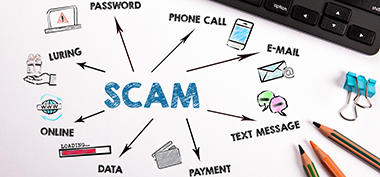Tips to help protect you and your money

Did you know that, according to information recently published by the Federal Trade Commission (FTC), consumers reported losing $12.5 billion to fraud in 2024. The second highest category of reported losses came from imposter scams. In these scams, scammers pretend to be someone that you know and trust, such as a representative from your bank or the government, to try to get you to send money or share your personal information.
In fact, the FTC found that “bank impersonation” scams were the most reported scam occurring through text messages in 2022, up nearly twentyfold since 2019. In a bank impersonation scam, scammers pretend to be from a bank and request your personal information, like Social Security numbers, credit card or debit card numbers, or your bank account passwords. The text message often looks like a bank security message and tries to create a sense of urgency to encourage you to provide your personal information.
For example, you might receive a text message asking you to verify a large purchase you didn’t make, and, if you respond, you might get a call from someone pretending to be from the bank’s fraud department, who asks you for your personal information. The scammer then uses the information to steal money from your account. According to the FTC, a typical consumer who falls for this scam lost $3,000, plus was at risk for identity theft.
When you get a text message that makes you worry or seems fishy, take your time and call your bank directly, using a phone number that you are familiar with, like the number provided on your debit or credit card. Do not use a phone number provided by someone you are unfamiliar with or that you think may be a scammer. As an alternative, contact the FDIC before you provide any information when something does not seem right.
Also, do not click on any links in the message or provide information unless you are certain you are dealing with your bank.
Text messages are not the only way scammers will try to reach you. They also use emails (“phishing”) and phone calls (“vishing”). Learn how to identify these scams and better protect yourself and your money.
Am I dealing with a legitimate, FDIC-insured bank?
Criminals also create fake bank websites to mislead and entice people into transferring money or disclosing personal information. Some of these fake bank websites fraudulently use the FDIC name or “Member FDIC” logo to instill a false sense of security. Sometimes, it is hard to tell which websites are real and which are fakes. Before engaging with any website or an entity that claims to be an FDIC-insured bank, it is important to make sure that the website really belongs to an actual FDIC-insured bank.
To help you determine if a website belongs to an FDIC-insured bank, check the FDIC BankFind Suite: Find Institutions by Name & Location, a data resource on the FDIC website. You can look up banks by name or website address to verify whether they are a real FDIC-insured institution. Compare the bank name with the web address or URL. Watch for misspellings, such as letters that are out of place or where the bank name appears as a sub web address of the fake name.
The FDIC can help you verify whether a website is a fake bank or the legitimate website of an FDIC-insured bank, so contact us, and we can verify it for you. If you are in doubt or identify a suspicious website related to FDIC insurance, please contact the FDIC National Center for Consumer and Depositor Assistance (NCDA) at 1-877-ASK-FDIC (1-877-275-3342) to speak with a deposit insurance specialist or go to FDIC: Information and Support Center - Home.
Additional Resources
FDIC Consumer News: Avoid Scams While Shopping Online for Bargains
Federal Trade Commission: How To Avoid Imposter Scams
American Bankers Association: Banks Never Ask That!
For more consumer resources, visit FDIC.gov, or go to the FDIC Knowledge Center. You can also call the FDIC toll-free at 1-877-ASK-FDIC (1-877-275-3342). Please send your story ideas or comments to ConsumerEducation@fdic.gov. You can subscribe to this and other free FDIC publications to keep informed!
